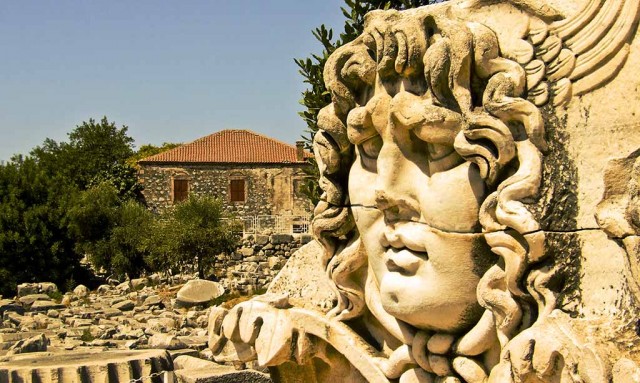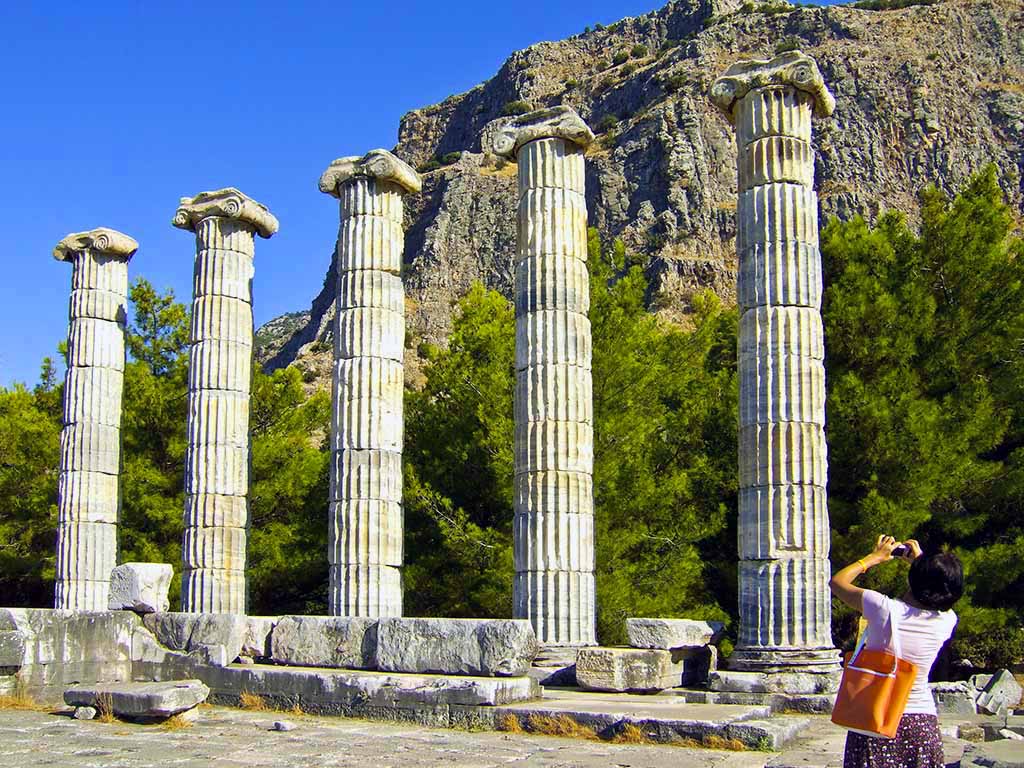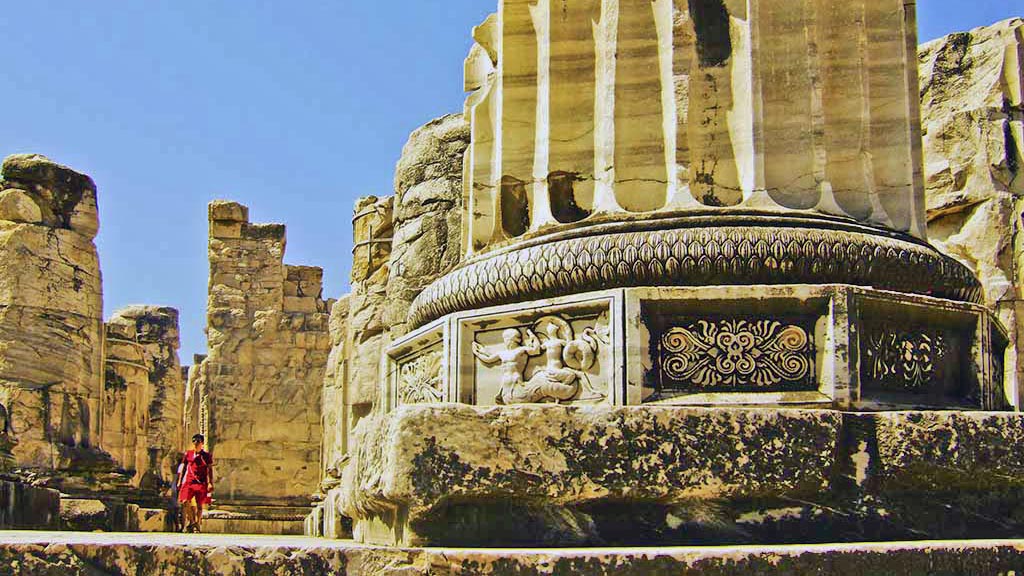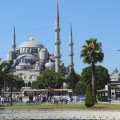
Hopefully it won’t be long until we can again enjoy carefree cruising. European cruising is resuming and Turkey which had been off the cruise map for a while is back on itineraries in 2021.
To whet your appetite, here’s a story from a fascinating shore excursion to classical cities in Turkey that’s off the beaten track. This story first appeared in the Cruisington Times in 2012:
On a typical day, over 20,000 people visit the ruins of the famed city of Ephesus, Turkey, and the majority of them come from cruise ships that dock in the port of Kusadasi. Ephesus is definitely not to be missed if you haven’t been there before, because its vast scale and beautifully preserved facades, including its famous multi-story library, give a sense of the grandeur and comfort of ancient life.
But if –like me– you’ve visited here before, the opportunity to visit other important ancient cities that are overshadowed by Ephesus becomes alluring. That’s why Holland America Line has created an expanding program of Explorations Central (EXC) shore excursions for repeat guests who crave new experiences.
Arriving aboard the Noordam in Kusadasi, I was intrigued by a day-long tour that visits three remarkable sites along the Turkish coast that had been bustling Greek or Roman cities at the time of Christ. Like Ephesus they were abandoned when sea levels changed and their harbors became filled with silt, leaving them landlocked far from the sea.
The specialty tour is small — there were only 20 people in my group — and it has an expert as a guide. Mert Taner, a classical archaeologist who served a stint with the Turkish forces in Kandahar, is so personable he was featured in a television series on ancient sites that appeared on the Public Broadcasting Service. Even the bus had a special feel, with Turkish carpet on the aisle.
We head south along the Aegean coast, on a completely different route than the two dozen buses heading north from the ship to Ephesus. For most of the day, we’ll be in a lush valley of olive groves and cotton fields that’s much greener than anything we’ve seen on our previous port calls in Greece. This valley, covering hundreds of square miles, is the most productive agricultural area of Turkey and in the fall the fields appear snow-covered with the white of ripe bolls of cotton, a major crop. It’s a sight you won’t see on the road to Ephesus.
None of us were prepared for the quality of the lesser-known sights we were about to visit:

Priene, the city made famous by Alexander
We’re the only bus pulling up to the steep walkway that leads to the city that Alexander the Great made his headquarters during a siege of nearby Miletus in 334 B.C. Built high on a hill, the city was easy to defend but not easy to get into. The Greeks built a long, steep stair case at its entrance, whose stone treads with square, chiselled corners are still remarkably intact today. It’s a challenging climb, but huge pine trees that offer shade and a cooling breeze keep the temperature bearable.
A highlight of the city is the meeting chamber of the city’s council, with stone benches on either side that set the standard we still use today: the liberals sat on the left and conservatives on the right. It once had a roof, but today it’s open to the sun and not conducive to extended sitting. It made me think that having political debates in the sun might be an excellent idea: it would make it easier to get politicians to keep their speeches short.
In the center of town, a soaring temple shows how precise the building technology was in the 5th century B.C. A series of soaring, fluted columns that had all been cut by hand fit perfectly together and are topped with ionic capitals. Precise carving was an art, despite the lack of modern power tools. In the amphitheatre, the stone seats are so ornate, they even feature feet shaped like lion’s claws.

Miletus, a city founded on a vision
The farm fields on the unassuming road that leads to the fortress-like ruins of Miletus are strewn with the remains of walls and columns of what was once a sprawling city. According to a legend, the location was chosen by a prince from Athens who was told by an oracle to found a city where he sighted a golden dolphin. True or not, the city must have been a shining place in its day. It became an important trading center and was the birthplace of famed architects who perfected building with arches that are the key features of an enormous ampitheater, whose stones were joined precisely without the use of any mortar.
The Roman baths established by the wife of Roman Emperor Marcus Aureleus in 170 A.D. are among the best preserved of Turkey’s ancient buildings. Its caldarium (hot room) was the original Turkish bath, with a water heating system still intact under its floor that created clouds of steam. Sculptures around the room include a beautifully carved lion, with every hair in its mane precisely chiselled.

Didyma, the city of a fabled oracle
The most jaw-dropping site was kept for last: the Temple of Apollo at Didyma. In the 4th century B.C. this was home to an oracle, who rivaled the famous oracle of Delphi. Everything about it was designed to be as awe-inspiring as the mythical city of Oz. Presiding over it all–so it’s told–was an all-wise wizard who could tell your future, for the appropriate offering, of course.
Think of it as the consultancy of its day. You approached a temple ringed with over 80 ornate columns that soared impossibly high and were greeted by an assistant to the great oracle, who remained unseen. You explained your dilemma and what you were prepared to pay for an answer. The temple in gleaming white marble was so vast and beautiful, you could hardly imagine they weren’t in touch with knowledge mere mortals couldn’t fathom.
It’s now believed the oracle was indeed high, perhaps due to fumes or a form of natural laughing gas that’s emitted from the underground spring beneath the temple. Suffice it to say it was a great money maker for those who ran the show and it may have actually helped people make up their minds. Today, it’s still awe-inspiring and an extremely well preserved example of just how intricate ancient stone craftsmanship could be.
At seven hours plus, the tour — which included lunch with a view of the Temple of Apollo and a demonstration of carpet weaving —became a long day, but a very satisfying one. And it seemed to be exclusive to Holland America. Consider it the next time you visit Kusadasi on one of their cruises.






Thank you for the very interesting article and excellent photos. Can’t wait to visit Turkey on my next cruise.